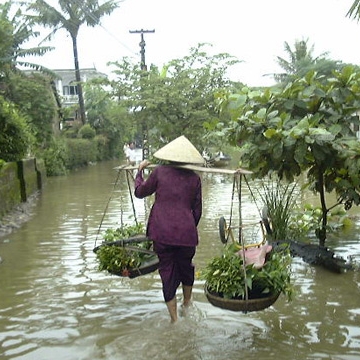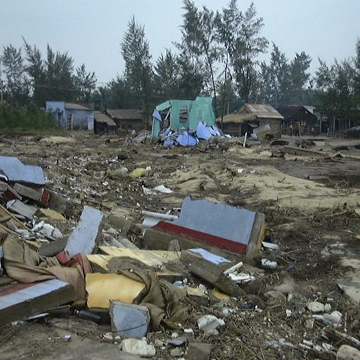Pakhar ravages southern provinces
4 April 2012
After slamming into the southern coast on April 1, tropical storm Pakhar weakened quickly and caused great property damage to the south-eastern region.
* In Ho Chi Minh City, the country’s largest economic hub, torrential rains accompanied by strong winds brought down many big trees, flooded major roads, and caused a power outage for several hours.
Strong winds uprooted big trees on Le Duan, Nguyen Du, Dinh Tien Hoang, Nguyen Van Thu, Nguyen Trai, and Truong Dinh in districts 1, 3, 5, as well as in Tao Dan and April 30 parks.
A motorcycle driver was seriously injured and hospitalised after a big tree on Nguyen Van Linh road fell down on him.
Scaffolding structures of construction projects on Thai Van Lung, Vo Van Ngan and Ta Quang Buu collapsed, and several roads were condoned off by local police and militiamen to ensure traffic safety.
Torrential rains also caused widespread flooding in districts 7, 9, 12, Tan Binh and Thu Duc, with many places 10-30cm deep under water.
In the evening, several districts suffered from a power blackout for several hours. At 22.00 power workers were working hard to restore electricity in districts 1, 3 and Nha Be.
In Can Gio district alone, four houses collapsed, 16 others had roofs blown off, 11 vessels sank and another was washed away.
More than 2,000 local residents living in flood-prone areas of Can Gio district had moved to cultural houses and schools before the storm made landfall.
At 21.00 Binh Khanh ferry station linking Can Gio and Nha Be districts resumed operation to clear traffic congestion between the two ends.
* In Ba Ria-Vung Tau province, three local residents were injured, 23 houses collapsed, and roofs of 140 other houses were torn off. Ba Ria town was the hardest hit, with 102 collapsed or damaged houses.
No big damage was reported in the island district of Con Dao thanks to thorough preparations, according to border guard station 540.
Although the storm dissipated, provincial search and rescue forces are on standby for fears of possible severe flooding and landslides.
* Torrential rains also caused a massive blackout in Binh Duong province, a gateway to HCM City. Local residents in Thu Dau Mot town were without power for several hours.
Strong winds brought down fruit trees in blossom in Binh Nham and An Son communes and Lai Thieu town, causing huge damage to local farmers.
The provincial flood and storm control warned towns and districts of whirlwinds that could damage hundreds of hectares of rubber and subsidiary crops, as well as local houses.
*** In the central coastal province of Khanh Hoa, a farmer was reported missing in the mountain district of Khanh Vinh on April 1. Ha Huong, 35, from Son Thai commune, was believed to be washed away by the violent currents of the Cho river on the way home from the rice field.
Heavy rains also submerged at least 700 hectares of winter-spring rice in the province due to harvest in a couple of days.
A serious landslide occurred at section Km42+800 of Son Thai commune, Khanh Vinh district, on the evening of April 1. A total of 5,000 cubic metres of soil and rocks blocked traffic on the road.
Excavators and workers were mobilised to clear a way through and the traffic began to temporarily flow again at 02.00am on April 2. As large pieces of rocks blocked the road, explosives will be used and the traffic is expected to return to normal in 4 to 5 days.
Abnormal phenomenon
According to Le Thi Xuan Lan, a senior expert from the Southern Hydro-meteorological Station, Pakhar was an unusual storm, since statistics covering the past 40 years showed that there were only seven storms that occurred in March, only one of which affected Vietnam.
Most of the storms that formed outside of the usual season faded away when they were still at sea. During the period prior to June, the surface of the sea is usually rather cold, and thereby cannot provide enough energy for a storm to sustain itself, and such storms usually move north as well.
Pakhar, on the hand, churned for 5 days at sea, moved west-northwest, and weakened only when it entered Southern Vietnam.
The abnormal phenomenon was possibly due to the fact that climate change has caused the sea surface to warm more than usual and facilitated the storm’s development, Lan said.
She also forecast that the country may experience 6-7 storms this year, 1-2 more than the average of previous years.











